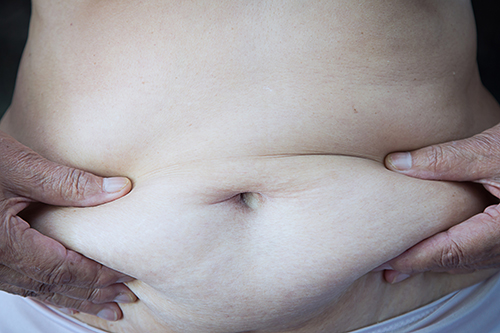![New study finds that body fat distribution in the trunk is more important than body weight when it comes to cancer risk in postmenopausal women. [Sasiistock/Getty Images]](https://genengnews.com/wp-content/uploads/2018/08/Sep11_2017_Getty_478295632_BellyFat_5002041279912-1.jpg)
New study finds that body fat distribution in the trunk is more important than body weight when it comes to cancer risk in postmenopausal women. [Sasiistock/Getty Images]
It would be difficult to watch TV these days and not hear about how excess fat around the abdominal region is unsightly and that for only $19.95, the latest snake oil treatment will send those fat cells to Valhalla, leaving you with the body of a Greek god. However now, investigators at the University of Copenhagen, Denmark, have just presented data at the 2017 European Society for Medical Oncology (ESMO) meeting providing evidence that body fat distribution in the trunk is more important than body weight when it comes to cancer risk in postmenopausal women—putting a new spin on weight management priorities for women in this age-group. Findings from the study were presented in a poster entitled “A study of body fat composition, derived from DXA-scans, in association with cancer incidence in postmenopausal women.”
“When assessing cancer risk, body mass index (BMI), and fat percentage may not be adequate measures as they fail to assess the distribution of fat mass,” explained lead study investigator Line Mærsk Staunstrup, a doctoral candidate at the University of Copenhagen and Nordic Bioscience, ProScion. “Avoiding central obesity may confer the best protection.”
Using information from national cancer registries, the study included 5,855 Danish women (mean age 71 years) who underwent baseline dual-energy X-ray absorptiometry (DXA) scans to assess body fat and body fat composition and have been followed for 12 years. Furthermore, the study recorded 811 solid cancers in the women and showed that the ratio of abdominal fat to peripheral fat was a significant independent predictor of cancer diagnosis up to 12 years after baseline (hazard ratio [HR] 1.30; 95%, CI: 1.11 to 1.52; p < 0.001). Neither BMI nor fat percentage showed significance.
“The average elderly women can very much use this information, as it is known that the menopause transition initiates a shift in body fat towards the central trunk area. Therefore, elderly women should be especially aware of their lifestyle when they approach the pre-menopause age,” Ms. Mærsk Staunstrup noted. “Clinicians can additionally use the information for a preventive conversation with women who are at higher risk of cancer. While clinicians have access to whole-body DXA scanners at most hospitals, portable DXA scanners have become available on the commercial market, and this may allow regional bone and fat scanning. However, it may not be the most reliable for measuring central obesity.”
The research team found 293 breast and ovarian cancers, 345 lung and gastrointestinal (GI) cancers, and 173 other cancers. Looking in detail at specific cancers and risk factors the investigators determined that only lung and GI cancers were associated with high abdominal to peripheral fat ratios (HR: 1.68; 95%, CI: 1.12 to 2.53; p < 0.05 and HR: 1.34; 95%, CI: 1 to 1.8; p < 0.05, respectively).
Additional cancer risk factors were age, hormone replacement therapy, and smoking. But after controlling for these risk factors, the fat ratio remained an independent risk factor.
“While obesity has previously been linked to cancer risk, the link to lung cancer is new and intriguing,” commented Andrea De Censi, M.D., director of the Medical Oncology Unit of the National Hospital E.O. Ospedali Galliera, in Genova, Italy. “Increases in insulin, resulting from over-consumption of simple carbohydrates such as potatoes, wheat, rice, and corn, results in fat accumulation that is specifically visceral and abdominal. Insulin also has detrimental effects on hormone production, and adipose cells in fat tissue increase chronic inflammation throughout the body, another risk factor for several cancers.”
Dr. De Censi concluded that “these data open the door for clinicians to initiate some interventions in obese patients. In addition to fat loss with diet and exercise, there may be a potential role for a diabetes drug, such as metformin, which can lower insulin effects and contribute to cancer prevention.”






